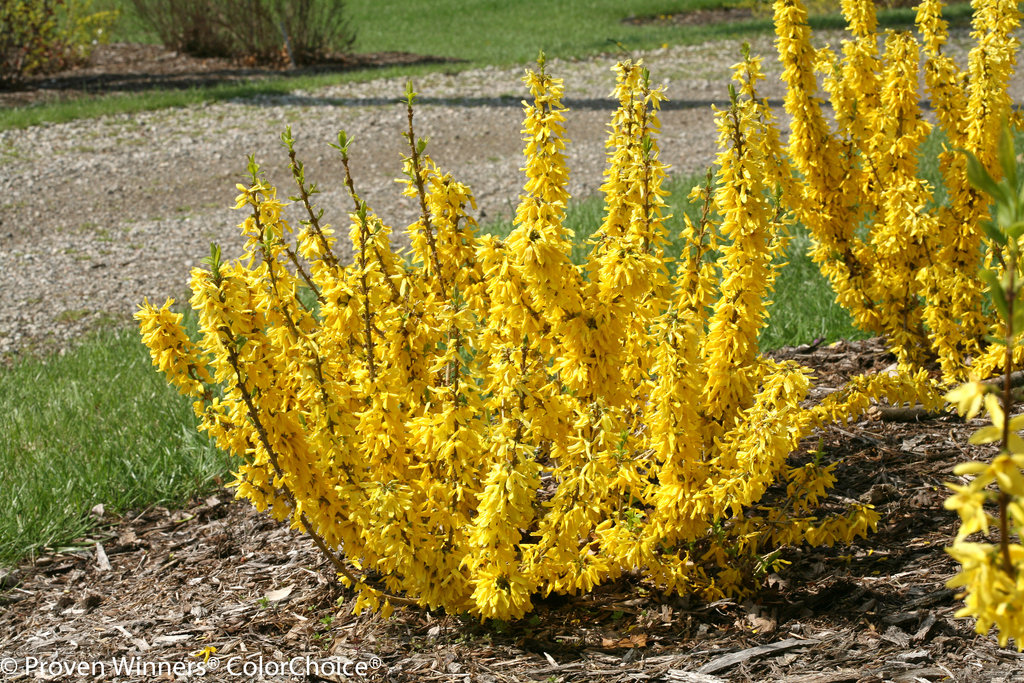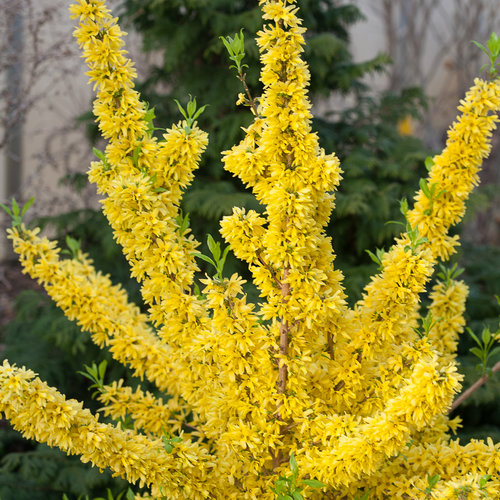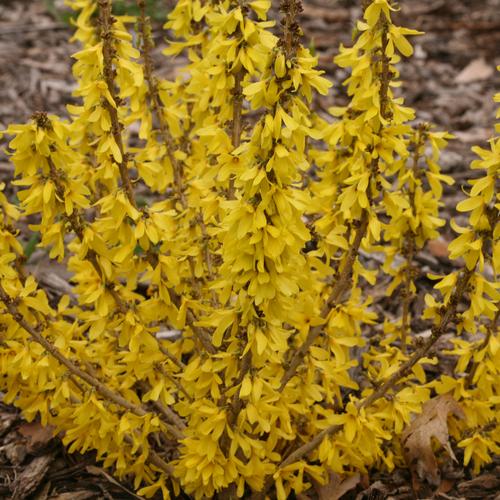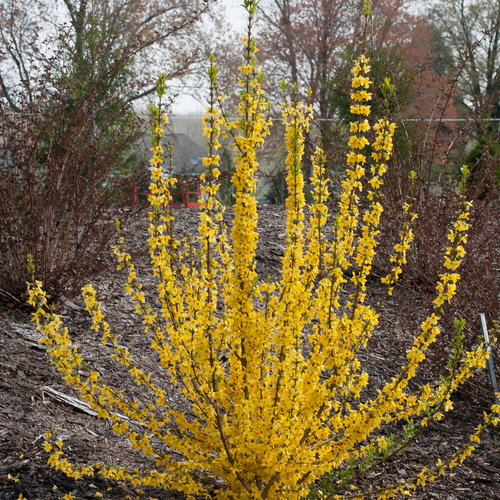Forsythia - The Ultimate Growing Guide from Proven Winners®
Brighten up the early spring garden with the cheerful flowers of this easy to grow long-lived shrub
 Buy forsyhtia shrubs - Order online and have them shipped right to your door
Buy forsyhtia shrubs - Order online and have them shipped right to your door
The cheery blooms of forsythia bush provide a welcome burst of color at a time of year when gardeners need it the most. One of the earliest flowering shrubs, forsythia has a graceful arching or upright habit and is grown primarily for the golden yellow four-petaled flowers that appear in early spring before the foliage emerges. This deciduous ornamental shrub can reach up to 20 feet tall and 10 feet wide, though some newer varieties have a smaller stature.
Forsythia is tolerant of a wide range of growing conditions and is reliably hardy in most climates. In colder regions where flower buds are more susceptible to freeze damage, hardier cultivars are recommended. When this fast-growing bush is finished blooming, the dense foliage provides a lush backdrop to other plants. Use this versatile shrub in borders, containers, foundation plants, woodland borders, as hedging or screening. Here’s how to grow and use forsythia in your yard.
FORSYTHIA CARE & PLANTING
How to plant: When planting forsythia, choose a site with full sun to light shade and well-draining soil. Follow these steps and space plants 3 to 10 feet apart, depending on the variety.
- Loosen soil in the planting area to improve drainage.
- Dig a hole twice as wide and just as deep as the root ball.
- Remove the plant from its nursery container and tease out the roots.
- Set the plant in the hole so the top of the root ball is level with or slightly higher than the soil line.
- Backfill the hole with soil, tamp down lightly to remove air pockets and water well.
- Water regularly until plants are established.
Learn more: How to Plant Shrubs
Soil: Forsythia is tolerant of different soils, but performs best in rich, well-draining soil. For containers, use a high-quality all-purpose potting mix.
Watering: Keep soil evenly moist but not soggy. Overwatering can cause root rot or fungal diseases. Water more often during prolonged heat or dry spells. Plants are somewhat drought tolerant once established.
Fertilizing: Forsythia plant needs little or no supplemental fertilizing. In late winter or early spring, apply a slow-release fertilizer that’s specially formulated for trees and shrubs according to instructions. Mulch plants around the base with a thin layer of compost or other organic matter to add nutrients, suppress weeds and retain moisture.
Pruning: Forsythia naturally has a handsome, wild habit. However, if you wish to shape it, wait until just after plants have finished flowering. Remove any branches that are dead, diseased or broken as needed. Plants pruned into formal hedging may experience a loss of some flowers. Rejuvenation pruning can be done every 4-6 years as needed. Cut out a few of the oldest branches completely to encourage new growth, which flowers the most abundantly.
TRY THESE PROVEN WINNERS® VARIETIES
Add these forsythia varieties to your landscape:
 Show Off® (Forsythia x intermedia) is a compact variety with prolific yellow blooms along the entire length of the stems. The shorter stature and upright branching makes Show Off® suitable for small urban yards, as hedging or in mass plantings. Plants need little or no pruning. Zones: 5-8 |
 Show Off® Sugar Baby® (Forsythia x) is a dwarf forsythia with an upright habit and dense branches that produce sunny yellow flowers from top to bottom. The miniature stature is suitable for smaller spaces. Use as a thriller element in containers or mass in the landscape for a dazzling early-spring display. Zones: 5-8 |
 Show Off Starlet® (Forsythia x) has a compact dwarf habit that stays neater than larger varieties, which can become out of control. The flower production on this improved variety is more vigorous, with a showy display of bright yellow flowers early in the growing season. Use in a foundation planting, mixed border, or as hedging. Zones: 5-8 |
FORSYTHIA FAQ’s
When to prune forsythia?
Forsythias bloom on old wood. Prune plants just after blooming. Pruning too late in the growing season will result in a loss of flowers the following year.
When does forsythia bloom?
Forsythia shrub is among the earliest shrubs to bloom. Plants flower from early to mid-spring, depending on the growing zone. Discover more spring flowers to add cheer to your garden.
Do deer eat forsythia?
Deer tend to leave forsythia bushes alone, though some grazing may occur if other food sources are scarce. See more deer-resistant shrubs.
Where is the best place to plant forsythia?
When growing forsythia, choose a site with full sun to light shade and well draining soil.
What does forsythia look like in summer?
Forsythia flowers occur before new foliage emerges. Green or variegated leaves are oval-shaped with pointed tips and serrated edges. The foliage holds its color throughout the growing season, creating a serene backdrop for borders and beds.
Is forsythia invasive? Do forsythia bushes spread?
Forsythia is not listed as an invasive species. Plants can spread rapidly, either through the roots or from branches that touch the ground and form new roots. These shrubs can be difficult to remove.
What is special about forsythia?
Forsythia bushes are one of the earliest shrubs to bloom, providing cheerful yellow color at a time of year when little else is in flower. See more yellow flowers.
Is forsythia easy to grow?
This tough shrub is one of the easiest garden plants to grow. Forsythia is tolerant of a wide range of growing conditions and performs well in most climates.
FORSYTHIA LANDSCAPING IDEAS
There are many ways to use forsythia in your landscape. Here’s how:
- Plant a forsythia hedge to divide garden areas.
- Place a dwarf type in a decorative container and display as a cheerful spring focal point.
- Add a smaller variety to a shrub border or foundation planting in combination with other shrubs that bloom at different times for season-long color.
- Naturalize in a woodland border with other early-season bloomers such as daphne, dogwood, spirea and flowering bulbs for a colorful spring display.
- Plant a larger variety as a privacy screen along a property line.
- Mass along a slope to help control erosion.
- Place in a mixed border where the neutral backdrop of green or variegated foliage will set off surrounding plants.
FORSYTHIA COMPANION PLANTS
Combine forsythia alongside other plants with similar cultural needs of full sun to light shade and well-draining soil.
For a shrub border or foundation planting, include forsythia alongside:
- Perfecto Mundo® Red reblooming azalea
- Sweet Emotion® hardy abelia
- Sunshine Blue® II bluebeard
- Gin Fizz® juniper
For a spring bed, plant alongside:
For a mixed border, combine forsythia with:
- Golden Shadows® pagoda dogwood
- Double Take® Peach quince
- Dolce® ‘Spearmint’ coral bells
- Still Waters™ clematis
Buy Proven Winners plants:




